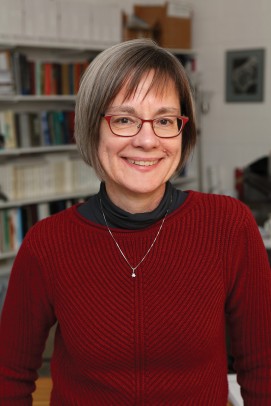Investigating toxic mercury in soil, water
Kathryn Nagy, professor and head of Earth and environmental sciences and professor in the Institute for Environmental Science and Policy, is a geochemist who studies how toxic mercury accumulates, migrates, and converts chemically in soils and water.
“There’s mercury everywhere,” Nagy said. “Globally, it comes out of the atmosphere — about half there is from volcanoes, and the rest from coal burning and incineration.”
The pollutant dissolves in water mainly as ionic mercury. It becomes a potent neurotoxin and works its way up the food-chain — especially in fish — after microorganisms convert the inorganic mercury into methylmercury. Nagy is trying to understand the geochemical conversions that keep mercury from becoming bioavailable — with the goal of predicting when and where mercury can be immobilized.
The element that binds to mercury the strongest is sulfur in its chemically reduced forms, she said, but it’s more complicated because the microbes that make methylmercury also chemically reduce sulfate to sulfide. The problem is understanding chemical changes in environmental sulfur simultaneously with changes in mercury.
“For example, with colleagues at the University of Colorado and the United States Geological Survey, we see in the Everglades that sulfate coming from farming activity is changed to sulfide and added to natural organic matter molecules which then can bind more mercury,” Nagy said.
She has been collaborating with French researchers in Grenoble to apply new techniques to characterize molecular binding at lower, environmentally relevant concentrations of mercury, using synchrotron X-ray absorption spectroscopy.
In a recent study, she and her colleagues showed that the amount of mercury sulfide mineral in soils downstream from the Department of Energy’s Y-12 National Security Complex in Oak Ridge, Tennessee, where mercury was used to produce fuel for the hydrogen bomb, could have formed entirely from reduced sulfur in natural organic matter — a surprising observation that challenges the view that microbes must form the sulfide from dissolved sulfate. In another study, distinct molecular forms of mercury in human scalp hair — at concentrations as low as 1 part per million —were identified from specific sources of exposure.
In 2015 Nagy was elected a fellow of the Geochemical Society and of the European Union of Geochemistry.
Nagy received her bachelor’s degree in geology at the University of Delaware; her master’s at Brown University; and her Ph.D. at Texas A&M University. She was a staff scientist at Exxon Production Research Company and Sandia National Laboratories in New Mexico before returning to academia as an associate professor of geological sciences at the University of Colorado, Boulder. She joined UIC as a full professor in 2002.

